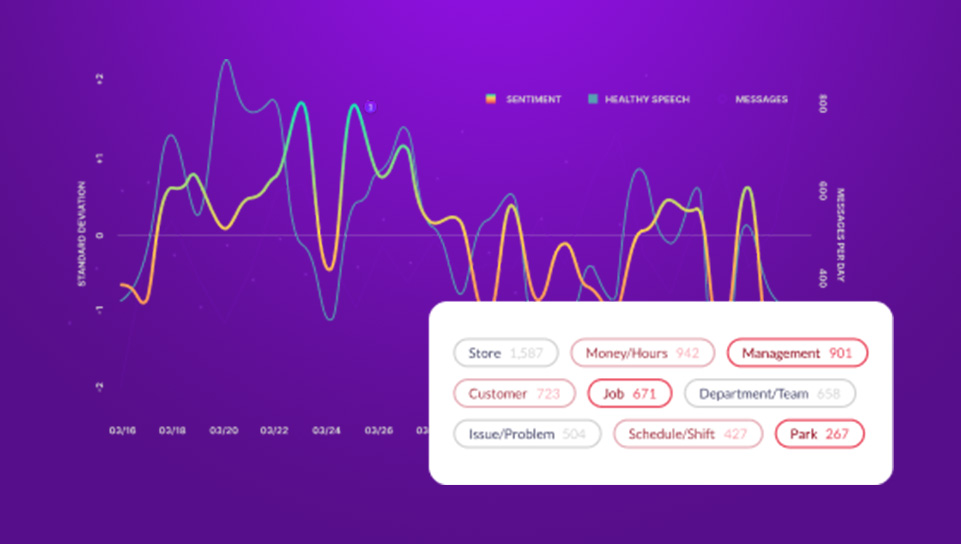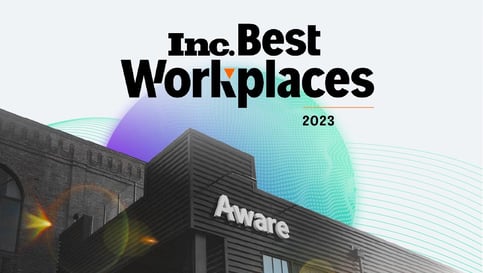How Employee Listening Improves Business Decisions for the Front Line
by Aware
The pandemic changed the employee-employer relationship for good. Here’s how the data your business already holds can help you navigate the new paradigm.
The COVID-19 pandemic fundamentally changed employer-employee relationships. In particular, how businesses responded to the heightened risk faced by frontline workers spoke volumes about how highly those employees were valued. Some companies rose to meet the challenge of the unprecedented crisis they faced, while others failed spectacularly.
With historic staffing and supply shortages continuing long after the onset of the pandemic, it’s critical to reflect on the past and understand what went right — and what went wrong. No matter how your business approaches the future, one thing is clear. We cannot go back.
How the Pandemic Impacted Frontline Workers
Frontline workers in retail, food and beverage, and hospitality industries were transformed overnight from low-income, low-prestige employees to “essential” workers who kept the country running. They were also the most at risk, according to data compiled by the University of California-San Francisco for medRxiv. During 2020, the most dangerous occupation in America was that of a line cook.
In addition to increased personal risk, frontline employees also bore the brunt of staffing and supply chain shortages. It’s no surprise that for many organizations, employee experience hit an all-time low during this period.
The Great Resignation that impacted almost every industry began with frontline employees. Some didn’t just quit their employer, but their entire profession. Retailers and food and beverage outlets have consistently struggled to maintain adequate staffing levels ever since. The truth is the workers they seek might not be around anymore to fill the vacancies.
An estimated 1.6 million Americans left the workforce because of long Covid. Another 300,000 working-age people have died. Still more lost access to childcare or simply became burned out. The Covid pandemic increased the retirement rate among older adults. Post-Covid, there are almost 2 million fewer women in the workforce, in large part because women’s careers were sacrificed when children or elderly relatives needed caretakers. And frontline positions were the hardest hit by all those losses.
Businesses must accept that many of their workers are simply not coming back. Labor is at a premium and hiring and retention will continue to be top of mind throughout the coming years. The companies that thrive in the future of work will be those that value their employees and prioritize their needs.

What do frontline workers care about right now? We analyzed social media data to find out.
What Frontline Employees Expect from Business Leaders
Navigating all this change and trying to reconcile business interests with frontline employee needs is incredibly difficult, especially when those needs and interests are often contradictory. But failure to successfully guide these transitions risks the company and its leaders being labeled out of touch and uncaring. With good workers already in short supply, it’s hard to be competitive with a poor brand image.
- One in five workers say their company doesn’t care about their work-life balance
- In Q2 2022, employee confidence in employers dropped to a two-year low
- There is a 57-point gap between executive perceptions of company trust, vs. employee and consumer opinions
- Just 35% say their leaders invest in their career development
Some of the largest companies are finding it the most difficult to pivot to meet the needs and expectations of their employees. Despite heavy investments in redesigning frontline environments at the onset of the pandemic, businesses remain unsure where to invest most effectively in the long-term. With so many voices clamoring to be heard, how can leaders distinguish what factors are influencing employees’ visions of the future?
Traditionally, enterprise businesses tapped into the voice of the employee through annual engagement surveys, occasionally augmented with pulse surveys throughout the year. The infrequency of these surveys is hardly enough in stable times and falls woefully short during periods of uncertainty and upheaval.
How long does it take your organization to devise, deploy and analyze surveys? How much time passes between inception and action? Do you take any action at all?
What many businesses report as survey fatigue might be better described as inaction fatigue. After the first or second survey employees might feel like their opinion matters, but after the fifth or sixth? If companies are constantly polling their workers but failing to respond swiftly to feedback, goodwill quickly atrophies, and employees will stop giving them the benefit of the doubt.
We’re living in a digital age, and employees expect faster reactions than quarterly surveys can provide. Even if businesses do manage to respond swiftly to feedback, change is happening so rapidly that insights from a survey a month or two ago could already be obsolete.
Learning to Listen Continuously and Lead with Empathy
So how do businesses get real, actionable insights that can boost worker satisfaction and confidence in difficult times? The answer is continuous listening. That means gathering employee feedback as often as possible, from as many different sources as possible. There are only so many surveys your People team can send out. Instead, think about other sources of data from your workforce.
- Establish a listening culture, with check-ins between employees and managers across the enterprise
- Proactively inform workers about news and updates in the company and solicit their feedback
- Create engagement panels that have a higher tolerance for polls and surveys
- Use qualitative data from frontline collaboration platforms to measure engagement and commitment
The more information you have about your employees, the clearer your oversight becomes. When businesses rely on a single source of employee sentiment — particularly a self-selecting one such as optional surveys — a few loud voices can quickly drown out the rest. That can lead businesses to make decisions based on the opinions of a vocal minority, alienating the majority.
Instead, leaders should look for ways to access as much feedback as possible, from every position on the front line. The opinions that have the greatest potential for driving the most effective change can often be the hardest to solicit. Employees on the margins, who watch but rarely engage, often have invaluable insight if you can get them to share it. And only those who have already checked out can tell you why they stopped caring — if you can get them to open up.
Collaboration tools such as WorkJam are ideal for disseminating information to employees and tapping into the subjects that are trending on the front lines. By combining continuous listening with empathetic leadership, you can make informed decisions about the future of your organization that benefit employees and the business.
How Aware Helps Leaders Make Empathetic Business Decisions
Business leaders must understand what challenges and motivates their employees. The topics that are top of mind of the front line can change overnight, and organizations must find new ways to uncover those changes and react accordingly. How are your employees coping — or failing to cope? How can the organization support them during difficult periods? What are they looking for from their employers?
More than anything, employees want to be seen as human and valued as people. Businesses must show that they care by responding empathetically to the hopes and fears and wants of their workforce. Lack of empathy from employers is the root cause of many factors motivating the great resignation.
Aware helps employers unlock actionable insights by extrapolating the authentic voice of the employee from collaboration communications at scale.
Take an aggregate overview of the topics that drive discussions and discover what matters most to the silent majority in your organization. Understand how top-down messages disseminate through the organization and how they’re received on the front line. Visualize where your messaging misses the mark and make adjustments on the fly. Only Aware can show you shifts in sentiment in near real-time and empower you to act to protect your brand image.
Aware is the only solution on the market that gives executives the insights they need to succeed in the new world of work. It’s tomorrow’s essential insights platform, available to business leaders today.









